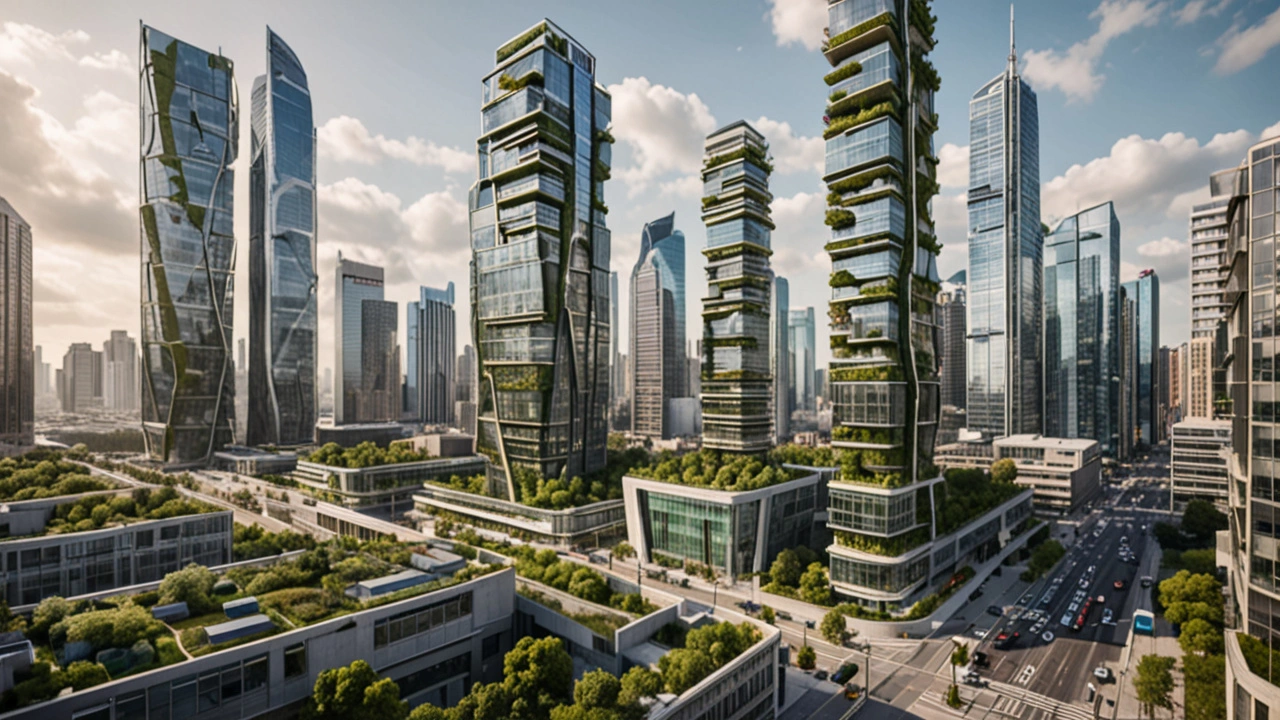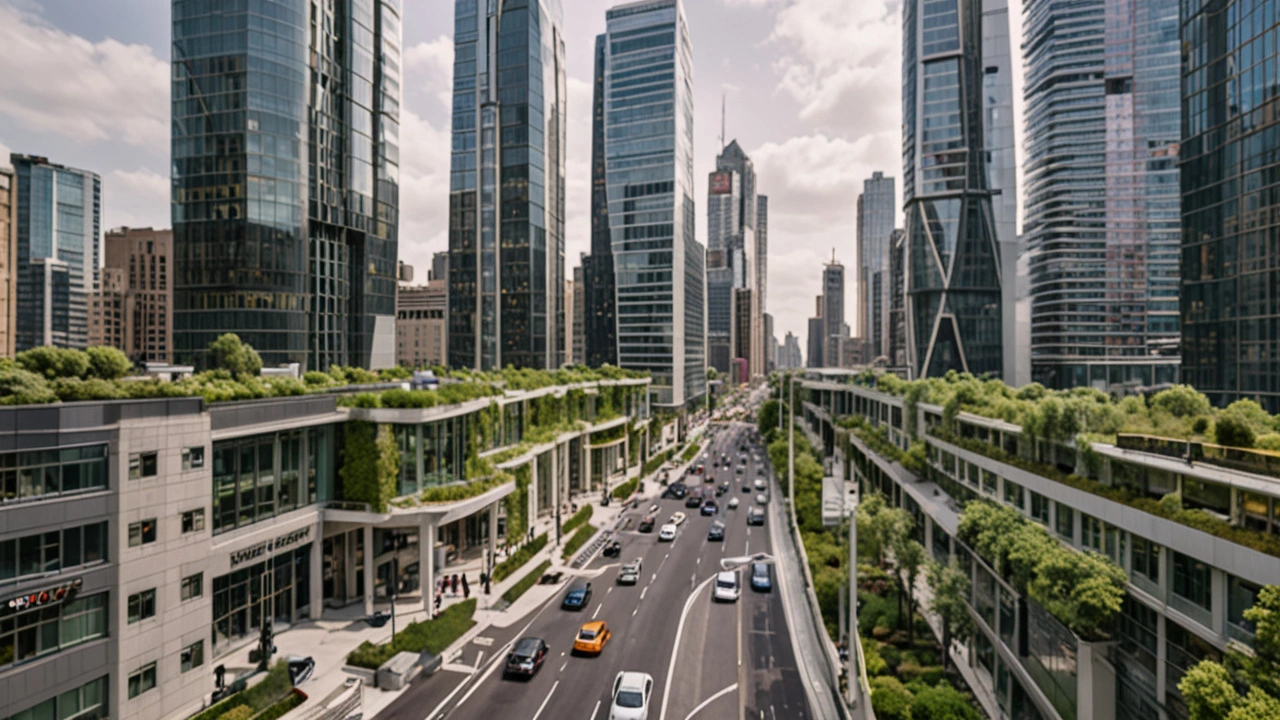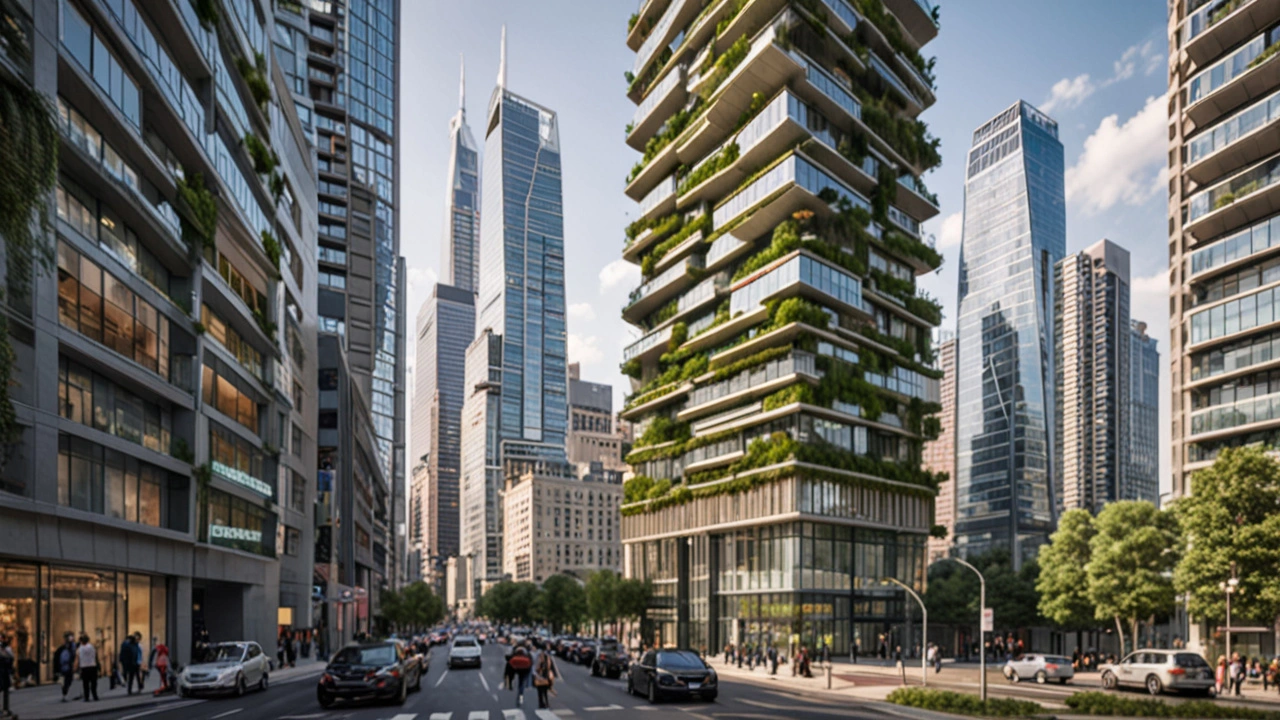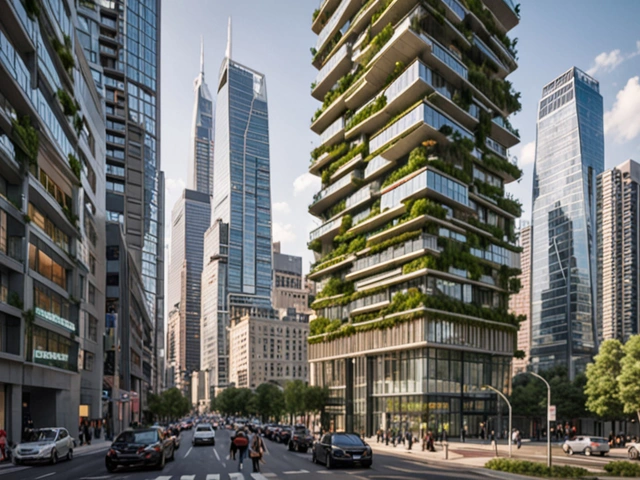High-tech architecture is not just a buzzword; it's a transformative approach reshaping the construction landscape. It merges cutting-edge technology with building design, setting new standards for functionality, efficiency, and aesthetics.
Smart building systems are at the heart of this movement, incorporating IoT devices, advanced sensors, and automation to create responsive and sustainable environments. These systems improve energy management, ensure safety, and enhance comfort, making buildings more livable and eco-friendly.
By focusing on sustainability, high-tech architecture promotes the use of renewable materials and energy-efficient practices. This reduces environmental impact and operational costs. Architects are now designing adaptive structures that can adjust to varying conditions, ensuring long-term relevance and usability.
As we look to the future, the potential of high-tech architecture is enormous. Emerging trends include 3D-printed buildings, self-healing materials, and AI-driven design processes. These innovations promise to push the boundaries of what’s possible, setting the stage for a new era in construction.
- Introduction to High-Tech Architecture
- Smart Building Systems
- Sustainability and Efficiency
- Adaptive Design Techniques
- Future Prospects and Trends
Introduction to High-Tech Architecture
High-tech architecture, also known as technological architecture or modernist architecture, is a design style that emerged in the late 20th century. It integrates advanced technological components and systems into buildings, creating structures that are not only visually stunning but also highly efficient and adaptive. The key aspect of high-tech architecture lies in its ability to incorporate cutting-edge technology into traditional construction methods, resulting in innovative and futuristic buildings.
One of the primary goals of high-tech architecture is to enhance the functionality and sustainability of buildings. This style emphasizes the use of materials such as steel, glass, and concrete, which are not only durable but also contribute to the overall aesthetic of the structure. The use of these materials allows architects to create open, flexible spaces that can easily adapt to changing needs. For instance, modern skyscrapers often feature open floor plans and panoramic glass walls that provide natural light and stunning views, all while maintaining structural integrity and energy efficiency.
A significant aspect of high-tech architecture is the integration of advanced systems and technologies into the design and construction process. For example, smart building systems utilize Internet of Things (IoT) devices, sensors, and automation to monitor and control various aspects of the building's operation. These systems can optimize energy usage, ensure safety, and enhance comfort for occupants. A study by the International Energy Agency found that smart building technologies can reduce energy consumption by up to 30%, making them a crucial component of sustainable design.
High-tech architecture also places a strong emphasis on sustainability and environmental responsibility. The use of renewable materials and energy-efficient practices helps reduce the ecological footprint of buildings. Many high-tech buildings incorporate features such as solar panels, green roofs, and rainwater harvesting systems to minimize their impact on the environment. An example of this is the Edge building in Amsterdam, which is often cited as one of the greenest buildings in the world. The Edge utilizes a combination of solar power, natural ventilation, and smart lighting to achieve energy neutrality.
Renowned architect Norman Foster, a key proponent of high-tech architecture, once remarked,
“As an architect, you design for the present, with an awareness of the past, for a future which is essentially unknown.”His words underline the forward-thinking nature of high-tech architecture, which aims to create buildings that are not only functional today but also adaptable for future needs. This adaptability is evident in the design of many modern high-tech structures, which often feature modular components and flexible layouts that can be reconfigured as needed.
The rise of high-tech architecture has also led to the development of new construction techniques. Prefabrication, for example, involves assembling building components off-site under controlled conditions, before transporting and installing them on-site. This method not only speeds up construction but also improves quality control and reduces waste. The Shard in London, designed by Renzo Piano, is a prime example of a high-tech building that utilized prefabrication techniques to achieve its towering height of 310 meters, making it one of the tallest buildings in Europe.
Smart Building Systems
The concept of smart building systems is fundamentally changing how we approach architecture and construction. These systems use advanced technologies to automate and control various building functions, ensuring optimal performance and user comfort. At the heart of smart buildings are IoT devices, which are interconnected through a centralized network, allowing real-time data collection and analysis. This connectivity enables buildings to respond dynamically to changing conditions, improving both efficiency and sustainability.
One key feature of smart building systems is energy management. By using smart sensors and control systems, buildings can monitor and adjust energy consumption, reducing waste and lowering costs. For instance, smart thermostats can learn the occupants' habits and adjust the temperature accordingly, while automated lighting systems can turn off lights in unused areas. According to a study by the American Council for an Energy-Efficient Economy, buildings equipped with smart systems can reduce energy use by up to 30%, significantly impacting the environment and the bottom line.
“Smart building technology is not just about convenience; it's about creating environments that are responsive and adaptable,” says Dr. Lisa Palmer, an expert in sustainable architecture from MIT. “These systems allow us to build spaces that are not only efficient but also attuned to the needs of their occupants.”
Safety is another crucial aspect enhanced by smart building systems. Advanced security features include real-time surveillance, automated access control, and integrated alarm systems. These measures ensure that the buildings are secure and can quickly respond to emergencies. For example, smart fire detection systems can not only alert occupants of a fire but also provide data to firefighters about the fire's location and intensity, improving emergency response effectiveness.
Comfort and user experience are also elevated through smart building technology. Automated systems can manage various aspects of the indoor environment, from temperature and lighting to air quality and acoustics. Smart windows can adjust their tint to control glare and heat, while advanced HVAC systems ensure optimal airflow and humidity. Studies have shown that these enhancements can significantly boost productivity and well-being among occupants.
The integration of smart technology in construction is also fostering the development of sustainable practices. Buildings can be designed with renewable energy sources such as solar panels and wind turbines, integrated with smart grids to optimize energy use and reduce dependence on non-renewable sources. Water conservation systems use sensors to detect leaks and monitor usage, ensuring sustainable consumption of water resources.
Looking ahead, the potential for smart building systems is vast. Emerging technologies like artificial intelligence and machine learning are paving the way for buildings that can learn and adapt to their environment over time. This dynamic adaptability means that future constructions will not only meet current needs but also evolve with changing demands and challenges, making them truly resilient and future-proof.
By embracing smart building systems, architects and builders are not only pushing the boundaries of modern construction but also contributing to a sustainable and efficient future. As these technologies continue to advance, the impact on our cities and lives will only grow more profound, heralding a new era of intelligent and responsive architecture.

Sustainability and Efficiency
Modern construction has seen a remarkable shift towards sustainability and efficiency, driven by the growing need to address environmental concerns and resource depletion. High-tech architecture plays a pivotal role in this transformation, incorporating eco-friendly materials, energy-efficient systems, and innovative designs that reduce waste and carbon footprints. This approach not only benefits the planet but also significantly cuts operational costs for building owners.
One of the key aspects of sustainable architecture is the use of renewable materials. Bamboo, recycled metals, and sustainable concrete are becoming favored choices. These materials have lower environmental impacts compared to traditional ones and often enhance the building's aesthetic appeal. Moreover, green roofs and walls, which involve planting vegetation on building surfaces, provide natural insulation, reduce urban heat islands, and promote biodiversity.
Energy efficiency is another cornerstone of high-tech architecture. Buildings today are being designed to make the most of natural light and ventilation, reducing the need for artificial lighting and air conditioning. Advanced glazing techniques, such as low-emissivity glass, minimize heat loss and gain, enhancing the overall energy performance of a structure. Additionally, integrating photovoltaic panels into building facades and rooftops is becoming a common practice, enabling structures to generate their own electricity.
According to the International Energy Agency (IEA), buildings and construction are responsible for 39% of carbon dioxide emissions globally, highlighting the critical need for sustainable practices in this sector.
Smart technology is also pivotal in boosting building efficiency. Internet of Things (IoT) devices, advanced sensors, and automation systems optimize energy usage by adjusting lighting, heating, and cooling based on occupant needs and external conditions. Building management systems (BMS) allow for real-time monitoring and control of energy consumption, helping to identify inefficiencies and potential savings. For example, smart thermostats can learn user behavior patterns and adjust temperatures accordingly, ensuring comfort while minimizing energy waste.
Water Conservation
Water conservation is another critical area where high-tech architecture shines. Innovative solutions like rainwater harvesting systems, greywater recycling, and low-flow fixtures help reduce water consumption. Automated irrigation systems adjust watering schedules based on weather conditions and soil moisture levels, ensuring optimal water use for landscaping.
Waste Reduction
Construction waste is a significant environmental issue, but high-tech methods aim to address it effectively. Prefabrication and modular construction techniques minimize on-site waste, as components are manufactured with precision in controlled environments and then assembled on-site. Additionally, digital design tools and Building Information Modeling (BIM) allow architects and engineers to plan structures meticulously, reducing material waste and errors during construction.
The benefits of sustainable and efficient construction extend beyond the environment. Occupants of green buildings often experience improved health and well-being due to better indoor air quality and access to natural light. Furthermore, energy savings and reduced operational costs provide long-term financial benefits, making sustainable buildings an attractive investment.
Adaptive Design Techniques
Adaptive design techniques are reshaping how we think about construction and architecture. By creating buildings that can adjust to the changing environment, architects are ensuring structures remain relevant and functional for decades to come. These techniques are essential for dealing with unpredictable weather patterns, changing urban landscapes, and the evolving needs of inhabitants. A great example of adaptive design can be seen in buildings that feature dynamic facades. These facades can change their orientation, shading, and even materials to respond to sunlight, temperature, and wind conditions. This not only improves energy efficiency but also enhances the comfort of occupants.
One area where adaptive design is making a significant impact is in energy management. Smart systems can detect when a building is not in use and adjust the heating, cooling, and lighting accordingly, reducing energy waste. These systems rely on a network of sensors and algorithms that continuously learn and adapt living patterns. The Bosco Verticale Towers in Milan, for example, use adaptive techniques with hundreds of trees and plants integrated into the structure. This 'living wall' helps regulate the climate inside the building while also providing a habitat for wildlife, showcasing the potential of this approach.
An interesting concept within adaptive architecture is the use of transformable spaces. Modern urban spaces often need to serve multiple purposes without requiring significant reconstruction. Rooms with movable walls or floors that can be adjusted offer a flexible solution. In commercial settings, this adaptability allows for offices to transition between different configurations effortlessly, accommodating various functions and team sizes. Such designs are becoming increasingly popular in residential buildings, where residents might want to convert a living room into a home office or a guest bedroom without a major overhaul.
The use of advanced materials is pivotal in making adaptive design successful. Materials like shape-memory alloys and self-healing concrete react to environmental changes and repair themselves when damaged. These materials increase the longevity and safety of buildings. For instance, shape-memory alloys can be used in the structure of smart windows that change tint in response to light exposure, helping to manage indoor temperatures efficiently. Self-healing concrete, on the other hand, contains microorganisms that activate when cracks appear, secreting limestone to fill the gaps, thus extending the life of the structure significantly.
Adaptive design is also venturing into the realm of emergency response. Buildings equipped with responsive systems can better manage crises, such as fires or earthquakes. For example, smart sensors can detect structural weaknesses in real-time and alert the necessary authorities, allowing for timely evacuations and repairs. Moreover, architects are exploring designs that allow portions of buildings to move independently, absorbing shock during seismic activity, and reducing the risk of collapse. This built-in resilience is especially critical in areas prone to natural disasters.
Looking ahead, the integration of AI and machine learning with adaptive design techniques holds immense promise. By analyzing vast amounts of data, AI can predict how buildings will need to adapt over time based on trends and past events. This information can inform more resilient and efficient design decisions. A notable quote from prominent architect Bjarke Ingels captures this sentiment well:
"The best way to predict the future is to design it."As technology advances, the potential for adaptive design to transform our cities and lifestyles becomes increasingly apparent.

Future Prospects and Trends
Looking ahead, the realm of high-tech architecture holds immense promise and potential for revolutionizing modern construction. One of the most exciting prospects is the advent of 3D-printed buildings. Not only do these structures significantly reduce construction time, but they also bring down costs and minimize material waste. Imagine a world where a house can be printed in just 24 hours, offering a rapid response to housing crises and natural disasters.
Another ground-breaking development is the use of self-healing materials. These materials can autonomously repair any micro-cracks or damages, thus enhancing the durability and lifespan of buildings. Researchers from the University of Colorado Boulder have already developed a concrete capable of self-healing, using a mix of bacteria and a rich nutrient blend. Such innovations mean reduced maintenance costs and a smaller carbon footprint.
Artificial Intelligence (AI) and machine learning are also set to play a pivotal role in the future of high-tech architecture. AI-driven design processes can optimize architectural plans, suggesting space-efficient layouts, ideal materials, and sustainable solutions. This not only enhances the efficiency of the design process but also ensures the final built environment is both aesthetically pleasing and functionally superior. In an interview with Architectural Digest, AI expert Dr. Jane Smith commented, "AI has the potential to transform architecture from static designs to dynamic, adaptive systems that respond in real-time to environmental changes."
Emerging trends also include the increasing incorporation of augmented reality (AR) and virtual reality (VR) in the architectural design process. These technologies allow architects to visualize and tweak their designs in a virtual space before any physical work begins. Clients can also use AR and VR to immerse themselves in the proposed designs, ensuring they are completely satisfied with their future spaces before construction even starts.
Lastly, there's a rising interest in biophilic design principles, which integrate nature into built environments. By including green roofs, living walls, and indoor gardens, architects aim to promote well-being and cognitive health. The incorporation of natural elements provides a calming effect, enhances air quality, and can even improve productivity. As urban spaces continue to grow, biophilic design serves as a bridge between the natural world and our need for functional living spaces.
The future of high-tech architecture is undoubtedly exciting and transformative. Innovations in 3D printing, self-healing materials, AI-driven designs, AR and VR integration, and biophilic design are not mere possibilities but inevitable realities. As these advancements continue to evolve, the boundaries of what is achievable in modern construction will surely expand, ushering in a new era of architectural excellence and sustainability.





